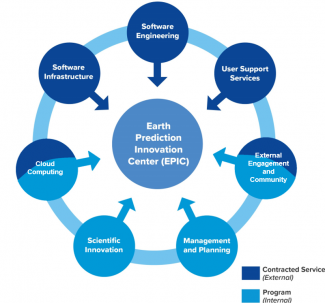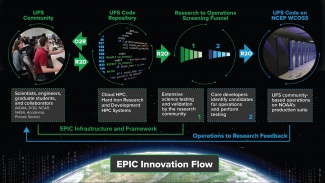On April 26, NOAA announced that Raytheon Intelligence & Space (RI&S) would be the development partner that would unite the community in developing the most user-friendly and user-accessible Earth modeling system in the world. This marks the end of a two-year planning process to establish the Earth Prediction Innovation Center (EPIC), and an exciting starting point for community members from academia, industry and government to work together to enable the most accurate and reliable operational numerical forecast model in the world.
The vision of EPIC can be traced back to 16 years ago when our beloved colleague and leader, Dr. William Lapenta, was the acting director of the Environmental Modeling Center, as part of his effort to reshape NOAA’s culture and stand up a path for the United States to reclaim and maintain international leadership in the development of operational numerical weather prediction systems. This vision has been embraced warmly by the weather enterprise, as well as NOAA leadership and U.S. lawmakers. In 2018, the National Integrated Drought Information System Reauthorization Act instructed NOAA to establish EPIC to accelerate community-developed scientific and technological enhancements into the operational applications for numerical weather prediction (NWP). NOAA’s Weather Program Office has started a journey to formally implement EPIC as a program since then. An overview of EPIC’s seven investment areas is shown in Figure 1.
The NOAA-RI&S partnership will take us to a next level toward seamless integration of the numerical modeling community across boundaries, to fulfill EPIC’s mission as catalyst for community research and modeling system advances that continually inform and accelerate advances in our nation’s operational forecast modeling systems, as illustrated in Figure 2. EPIC is working on setting up a public-facing virtual community model development platform populated with the Unified Forecast System codes, supporting datasets and test cases, providing community support in forms of online tutorials, community workshops, and a dedicated service desk, and implementing Continuous Integration/Continuous Delivery (CI/CD) pipelines on cloud and on-premises HPCs to enable Agile development, security, and operations (DevSecOps) processes that can greatly accelerate the infusion and testing of new ideas and innovations for model improvements and enhancements.
DTC’s experience and expertise in code management and user and developer support for the UFS weather model code base and applications are indispensable assets to the community. EPIC looks forward to working with DTC closely to offload these responsibilities, so that DTC can focus its resources and expertise on testing and evaluation to accelerate hierarchical testing of model physics and final transition to operations. What’s more important, EPIC and DTC will join forces to allow a much faster rate of innovation to research and to operations. An EPIC journey will continue to advance operational numerical weather prediction systems in open innovation and development for years to come.

